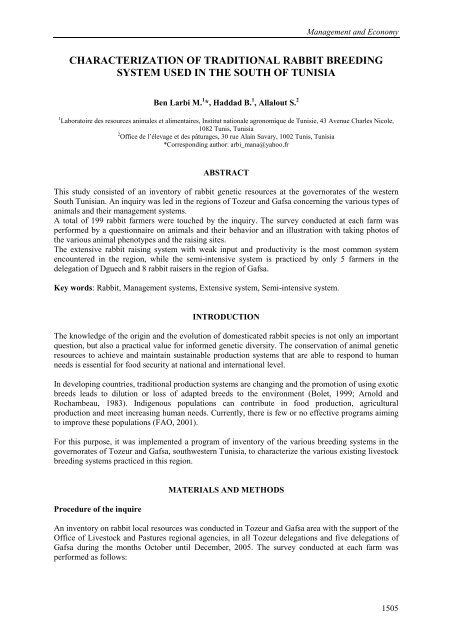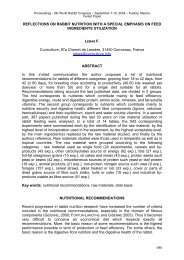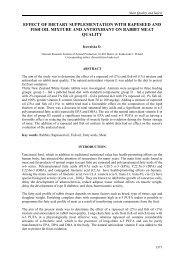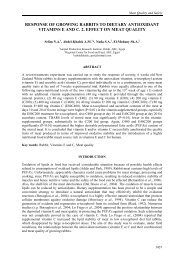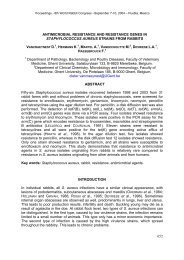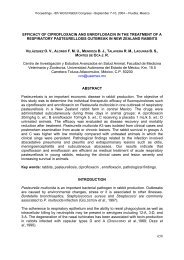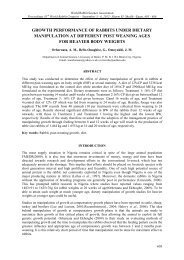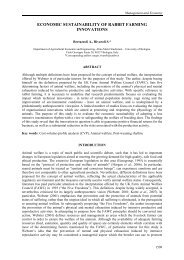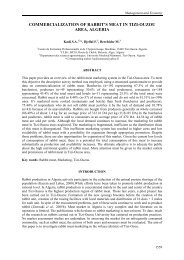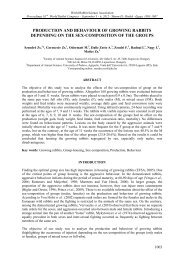characterization of traditional rabbit breeding system used
characterization of traditional rabbit breeding system used
characterization of traditional rabbit breeding system used
Create successful ePaper yourself
Turn your PDF publications into a flip-book with our unique Google optimized e-Paper software.
Management and Economy<br />
CHARACTERIZATION OF TRADITIONAL RABBIT BREEDING<br />
SYSTEM USED IN THE SOUTH OF TUNISIA<br />
Ben Larbi M. 1 *, Haddad B. 1 , Allalout S. 2<br />
1 Laboratoire des resources animales et alimentaires, Institut nationale agronomique de Tunisie, 43 Avenue Charles Nicole,<br />
1082 Tunis, Tunisia<br />
2 Office de l’élevage et des pâturages, 30 rue Alain Savary, 1002 Tunis, Tunisia<br />
*Corresponding author: arbi_mana@yahoo.fr<br />
ABSTRACT<br />
This study consisted <strong>of</strong> an inventory <strong>of</strong> <strong>rabbit</strong> genetic resources at the governorates <strong>of</strong> the western<br />
South Tunisian. An inquiry was led in the regions <strong>of</strong> Tozeur and Gafsa concerning the various types <strong>of</strong><br />
animals and their management <strong>system</strong>s.<br />
A total <strong>of</strong> 199 <strong>rabbit</strong> farmers were touched by the inquiry. The survey conducted at each farm was<br />
performed by a questionnaire on animals and their behavior and an illustration with taking photos <strong>of</strong><br />
the various animal phenotypes and the raising sites.<br />
The extensive <strong>rabbit</strong> raising <strong>system</strong> with weak input and productivity is the most common <strong>system</strong><br />
encountered in the region, while the semi-intensive <strong>system</strong> is practiced by only 5 farmers in the<br />
delegation <strong>of</strong> Dguech and 8 <strong>rabbit</strong> raisers in the region <strong>of</strong> Gafsa.<br />
Key words: Rabbit, Management <strong>system</strong>s, Extensive <strong>system</strong>, Semi-intensive <strong>system</strong>.<br />
INTRODUCTION<br />
The knowledge <strong>of</strong> the origin and the evolution <strong>of</strong> domesticated <strong>rabbit</strong> species is not only an important<br />
question, but also a practical value for informed genetic diversity. The conservation <strong>of</strong> animal genetic<br />
resources to achieve and maintain sustainable production <strong>system</strong>s that are able to respond to human<br />
needs is essential for food security at national and international level.<br />
In developing countries, <strong>traditional</strong> production <strong>system</strong>s are changing and the promotion <strong>of</strong> using exotic<br />
breeds leads to dilution or loss <strong>of</strong> adapted breeds to the environment (Bolet, 1999; Arnold and<br />
Rochambeau, 1983). Indigenous populations can contribute in food production, agricultural<br />
production and meet increasing human needs. Currently, there is few or no effective programs aiming<br />
to improve these populations (FAO, 2001).<br />
For this purpose, it was implemented a program <strong>of</strong> inventory <strong>of</strong> the various <strong>breeding</strong> <strong>system</strong>s in the<br />
governorates <strong>of</strong> Tozeur and Gafsa, southwestern Tunisia, to characterize the various existing livestock<br />
<strong>breeding</strong> <strong>system</strong>s practiced in this region.<br />
Procedure <strong>of</strong> the inquire<br />
MATERIALS AND METHODS<br />
An inventory on <strong>rabbit</strong> local resources was conducted in Tozeur and Gafsa area with the support <strong>of</strong> the<br />
Office <strong>of</strong> Livestock and Pastures regional agencies, in all Tozeur delegations and five delegations <strong>of</strong><br />
Gafsa during the months October until December, 2005. The survey conducted at each farm was<br />
performed as follows:<br />
1505
9 th World Rabbit Congress – June 10-13, 2008 – Verona – Italy<br />
1- A questionnaire on animals and their behavior. The data collected foc<strong>used</strong> on:<br />
• Environment interaction with management<br />
• Livestock <strong>system</strong><br />
• The animal populations managed<br />
• The number <strong>of</strong> males, females and young animals<br />
• Animal housing<br />
• Feeding <strong>system</strong><br />
• The reproduction <strong>system</strong><br />
• Health and sanitary status<br />
• Management results<br />
• Marketing <strong>system</strong>s.<br />
2- Illustration with taking photos <strong>of</strong> the various animal phenotypes and the raising sites<br />
Counted data<br />
The survey covered 199 <strong>rabbit</strong> breeders. The classification <strong>of</strong> the <strong>breeding</strong> <strong>system</strong>s was based on<br />
housing, food and the animals' reproduction <strong>system</strong>.<br />
Breeders’ distribution<br />
1506<br />
RESULTS AND DISCUSSION<br />
The breeder’s distribution was surveyed by delegation and recorded in Tables 1 and 2.<br />
Table 1: Rabbit breeders’ distribution among delegations in the governorate <strong>of</strong> Tozeur<br />
Delegation Number %<br />
Nefta<br />
Hazoua<br />
Tamarza<br />
Dguech<br />
Tozeur<br />
Total 171 100<br />
Table 2: Rabbit breeders’ distribution among delegations in the governorate <strong>of</strong> Gafsa<br />
Delegation Number %<br />
Gafsa<br />
El Guettar<br />
El Ksar<br />
Sidi Aïch<br />
El Snad<br />
Total 28 100<br />
Livestock classification <strong>of</strong> various <strong>system</strong>s<br />
31<br />
13<br />
29<br />
65<br />
33<br />
7<br />
6<br />
5<br />
4<br />
6<br />
18.12<br />
7.6<br />
16.95<br />
38.01<br />
19.29<br />
25.0<br />
21.4<br />
17.85<br />
14.28<br />
21.4<br />
The livestock <strong>system</strong>s encountered in the study area are divided into two types: the non improved<br />
livestock <strong>system</strong> and improved livestock <strong>system</strong>.<br />
1- The non improved livestock <strong>system</strong><br />
a) Housing<br />
According to the results, it was noticed that in this <strong>system</strong> <strong>of</strong> management <strong>breeding</strong> <strong>used</strong> is specially<br />
conducted in full colony. This <strong>system</strong> <strong>of</strong> management is intended to satisfy the family autoconsumption,<br />
the parents and their descendants are not separated, males and females are permanently<br />
mating in free open reproduction <strong>system</strong>. The females are more likely to be mated when they are in<br />
estrus.
Management and Economy<br />
Moreover, we noticed that breeders within this <strong>system</strong> rotate males among farmers, on borrowing base<br />
which will lead the livestock <strong>system</strong> to close small population with height in<strong>breeding</strong> percentages.<br />
The different housing <strong>system</strong>s met are as follows:<br />
− Open free management housing: In this <strong>system</strong> <strong>of</strong> livestock, the performances cannot be measured<br />
because <strong>of</strong> the animals' mobility.<br />
- Management under shade: In this <strong>system</strong> <strong>of</strong> livestock, equipment <strong>used</strong> could be self built or<br />
industrial deal.<br />
- Management under ground: The <strong>breeding</strong> under ground is a rural tradition <strong>system</strong> <strong>of</strong> management<br />
with low-cost <strong>of</strong> production and least labor demand. The <strong>rabbit</strong>, displays the instinctive behavior<br />
<strong>of</strong> burrowing underground to create tunnels to escape from predators but also to avoid exposure to<br />
high ambient temperatures. (Finzi et al., 1988).<br />
b) Reproduction management<br />
In the non improved <strong>system</strong>, reproduction performances are affected by the season. Indeed, the<br />
reproduction started very slowly in autumn, reaches its peak in spring and usually stops in the summer.<br />
The table 3 illustrates some reproductions performance computed in the study area.<br />
Table 3: Reproductions performance computed in the study area<br />
Characteristic Calculated average level<br />
Age <strong>of</strong> first <strong>breeding</strong><br />
6 months for females<br />
5 to 6 months for males<br />
Number <strong>of</strong> pups live born by kindling 4 to 9<br />
Average age at weaning 25 to 30 days<br />
Average weight at weaning 150 to 300 g<br />
Age at slaughter 45 to 60 days<br />
Live weight at slaughter 750 to 1500 g<br />
In the livestock where the reproduction <strong>system</strong> is totally free, in sprite <strong>of</strong> permanent activity <strong>of</strong> males<br />
most <strong>of</strong> them stop kindling in hottest months (July-August). Some does continue to reproduce but<br />
never reach to wean their pops. It was also observed the use <strong>of</strong> native animals because <strong>of</strong> their<br />
adaptation to the environment and local conditions.<br />
In most farms, the <strong>breeding</strong> males and females are replaced by their own <strong>of</strong>fspring. The only selection<br />
criteria are the shape and the health <strong>of</strong> animals which accentuates the risk <strong>of</strong> in<strong>breeding</strong>.<br />
c) Feeding <strong>system</strong>s<br />
Food is very diversified and consists <strong>of</strong> cereals, fodder, hay, dates, bread and left over food.<br />
Concentrate does not figure in the feeding practice.<br />
d) Health status<br />
Concerning health status in the non improved <strong>system</strong>, there is no follow-up by veterinarians with the<br />
exception <strong>of</strong> some breeders who use the vaccines at the beginning <strong>of</strong> April and November. Is was<br />
observed the use <strong>of</strong> Vinegar, sodium hypochlorite and aspirin diluted with water as disinfectant. The<br />
most diseases encountered are galls ears and diarrhea. The stillbirth is not high except under the<br />
warmer periods.<br />
e) Marketing <strong>system</strong><br />
Generally, production meat is devolved for the family own consumption, in addition to the direct sale<br />
<strong>of</strong> live animals.<br />
2- The improved livestock <strong>system</strong><br />
a) Housing<br />
The management is conducted under building with the equipments and accessories necessaries.<br />
1507
9 th World Rabbit Congress – June 10-13, 2008 – Verona – Italy<br />
b) Reproduction management<br />
In the improved livestock <strong>system</strong>, there is a good understanding <strong>of</strong> reproduction management, since<br />
there's a separation <strong>of</strong> <strong>breeding</strong> animals and their progeny. The does are introduced into the cage <strong>of</strong> the<br />
buck only at the time <strong>of</strong> the mating. The female age at the first kindly is four months, and five months<br />
in male. The number <strong>of</strong> pops by kindling varies from four to twelve born alive, the average age at<br />
weaning is 25 days and the weaning weight varies from 300 to 500 g. The most frequent reproduction<br />
<strong>system</strong> <strong>used</strong> is mating during the first week post-partum or the second week after weaning.<br />
c) Feeding <strong>system</strong>s<br />
Food is based on concentrate with a frequency <strong>of</strong> daily rations. In addition, the feed intake could be<br />
insured by the use <strong>of</strong> dry fodder.<br />
d) Health state<br />
Concerning health status in the improved <strong>system</strong>, there is a sanitary follow-up followed by the<br />
veterinarian and the use <strong>of</strong> disinfectants in the water.<br />
e) Marketing <strong>system</strong><br />
The price <strong>of</strong> animals differs from the type <strong>of</strong> animals whether it intended for <strong>breeding</strong> or for<br />
consumption. The sale <strong>of</strong> the production is done directly to markets or direct sale <strong>of</strong> live animals.<br />
1508<br />
CONCLUSIONS<br />
The study showed the variability <strong>of</strong> the local livestock <strong>system</strong>s encountered in the south-west <strong>of</strong><br />
Tunisia. These types <strong>of</strong> farms have no technical assistance, and there is no strategy for their<br />
development. To initiate a program <strong>of</strong> conservation and improvement <strong>of</strong> <strong>traditional</strong> livestock we<br />
recommend: completing the inventory through the Tunisian territory in order to ascertain the current<br />
situation in a way as accurate as possible; improving the productivity <strong>of</strong> this by improving the<br />
<strong>breeding</strong> techniques suitable for the environment; supervision <strong>of</strong> farmers in organized units such as<br />
associations and organizations ensuring products collection and services supply (feed and medicines).<br />
REFERENCES<br />
Arnold J., Rechambeau H. de. 1983. Inventaire des races menaces et des actions de conservation: les animaux de basse-cour.<br />
Ethnozootechnie, 33.<br />
Boulet G. 1999. A programme for the inventory, characterisation, evaluation, conservation and utilisation <strong>of</strong> European <strong>rabbit</strong><br />
(Oryctolagus cuniculus) genetic <strong>rabbit</strong>. AGRI, (25), 57-70.<br />
FAO 2001. L’état des ressources zoogénétiques pour l'alimentation et l'agriculture dans le monde. Ed FAO, 2-5.<br />
Finzi A., Scapani, Tani A. 1988. Les élevages cunicoles dans la region du Nefzaoua en Tunisie. Rivista di Agricoltura<br />
subtropicale e tropicale, LXXXII (1-2).


